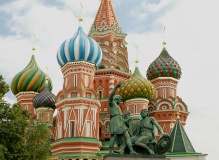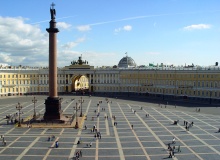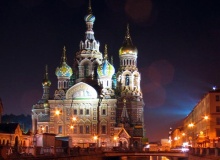Russia
Russia – a vast territory from the imperial beauty of Moscow and St Petersburg to bleak but romantic Siberian countryside.
Anyone embarking on Russia travel will find a country of contrasts—a vast territory rich in natural resources, where some are incredibly rich and millions are desperately poor. That said, a rising urban middle class is steadily changing the makeup of post-Soviet Russia. Most Russian dreams of prosperity are fuelled by foreign movies, television programs, extravagant Russian films, soap operas, commercials and billboards advertising luxury goods. But, for many, even standard material goods remain out of reach. Although the economy is recovering from the 1998 devaluation of the ruble, millions don't have access to the country's wealth, while others buy luxurious property abroad.
Today's Russia is often exhilarating, sometimes ominous. Everyday life goes on amid a jumble of trial-and-error capitalism, glitzy casinos, billboard politics, czar mania, slick gangster-hangout restaurants and posh nightclubs. Add to this mix a religious revival: hundreds of renovated Russian Orthodox churches are offering services in urban centres, and thousands of worshippers make pilgrimages to the country's monasteries and other sacred places.
So far, travellers haven't been affected directly by the country's turmoil. You'll find that the overall quality of hotels, restaurants and service is improving,
Travellers to Russia should be flexible, tolerant, patient and aware of risks. For such travellers Russia is simply a fascinating place—from the imperial beauty of Moscow and St. Petersburg to the bleakly romantic Siberian countryside.
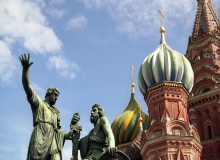
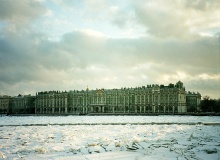
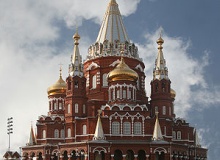
Moscow
Moscow, Europe’s most populous city, is now enjoying a time of unprecedented growth.
For Westerners, the Kremlin and the adjacent Red Square, especially the bulbous, multicoloured domes of St Basils Cathedral, have been an image synonymous with the Soviet Union and Russian state. The pre-revolutionary city is still visible in beautiful neo-classical wedding cake houses and concert halls, such as the Bolshoi Theatre.
Most surprisingly of all, there are the underground palaces of the Metro system, the largest and probably the most efficient in the world.
Nowadays, Soviet Revolutionary parades have been replaced by the throng of wealthy Muscovites with their shiny new Mercedes Benz. The impressive Stalinist buildings along Tverskaya ulitsa, the main drag leading up to Red Square, now house glitzy Western franchises.
Despite its dazzling wealth, glitzy shops and conspicuous consumerism, security is still omnipresent and the police have the power to ask for ID. Those without the right documents can be fined - tourists are no exception.
WHEN TO TRAVEL to Moscow
Moscow's climate consists of two seasons: winter and summer. In the deep Russian winter, the snow-covered landscapes are picturesque .and a solid snow pack covers the ground from November to March Days are very short.
Summer temperatures are comfortable until well into September with July and August being the warmest months. Train tickets and accommodation can be difficult to come by during these months, and attractions tend to be filled with visitors. Early summer, with its long days, and early autumn, with its colourful foliage, are many people's favourite seasons.
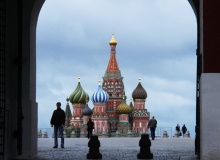
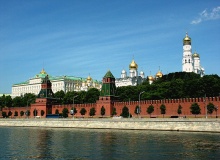
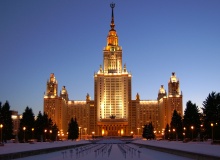
St Petersburg
After some major restoration work in 2003, St Petersburg’s main thoroughfares and shopping districts are thriving. From its dramatic birth in the early years of the 18th century, the city has suffered turbulent years of revolution, death, starvation, grim purges and the end of the Communist era in the 1990s.
Situated on the Baltic Sea, St Petersburg‘s magnificent architecture is astounding. With prodigious energy, Peter the Great oversaw the rise of St Petersburg from the islands and swamps around the River Neva. In the century that followed, his successors built ever more magnificent palaces, from the simple Italianate styles to grandiose Baroque constructions and the restrained neo-classical designs preferred by Catherine the Great.
Adding to the beauty of the buildings are the canals and rivers, which cross Nevsky prospekt. Like Venice, to which it is often compared, the winding waterways leading to the broad River Neva, are the real heart of St Petersburg.
St Petersburg is Russia’s first city in terms of beauty. It is also the prime centre for classical culture, from opera to ballet to music, with historic venues, such as the Mariinsky Theatre.
WHEN TO TRAVEL to St Petersburg
The city's northern latitude means long days in summer and long nights in winter - but in winter, hotels and tourist attractions are less crowded and there's a real magic to the night sky. The rivers and canals freeze in the depths of winter, while in midsummer all of Petersburg stays outdoors to enjoy the White Nights of this northern latitude, when the light is never quite extinguished.
